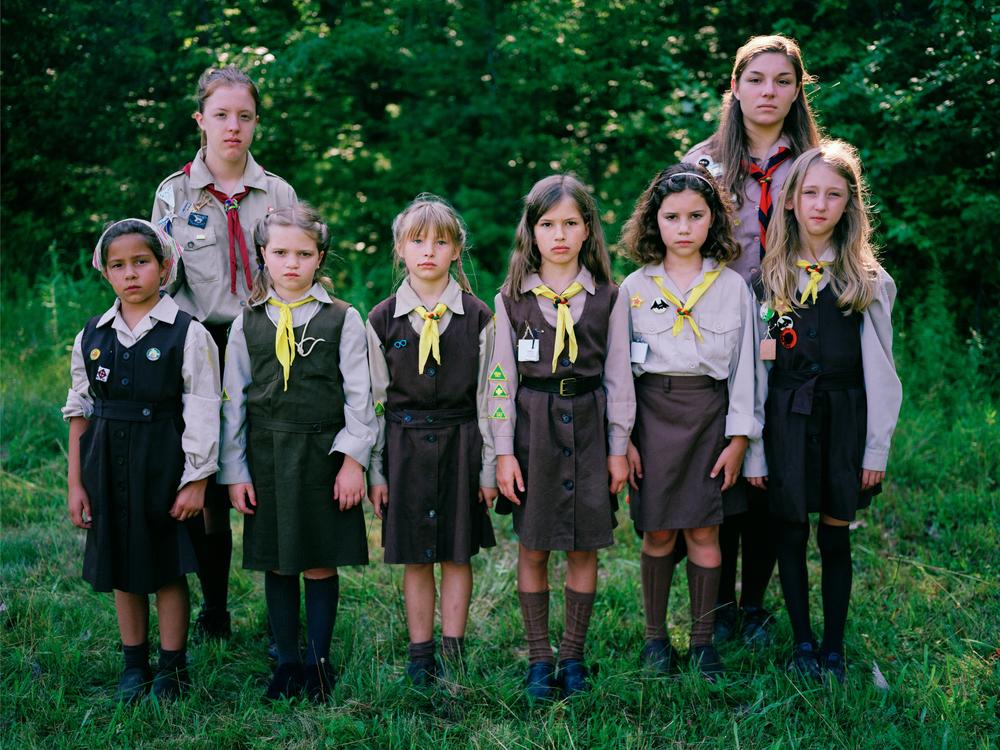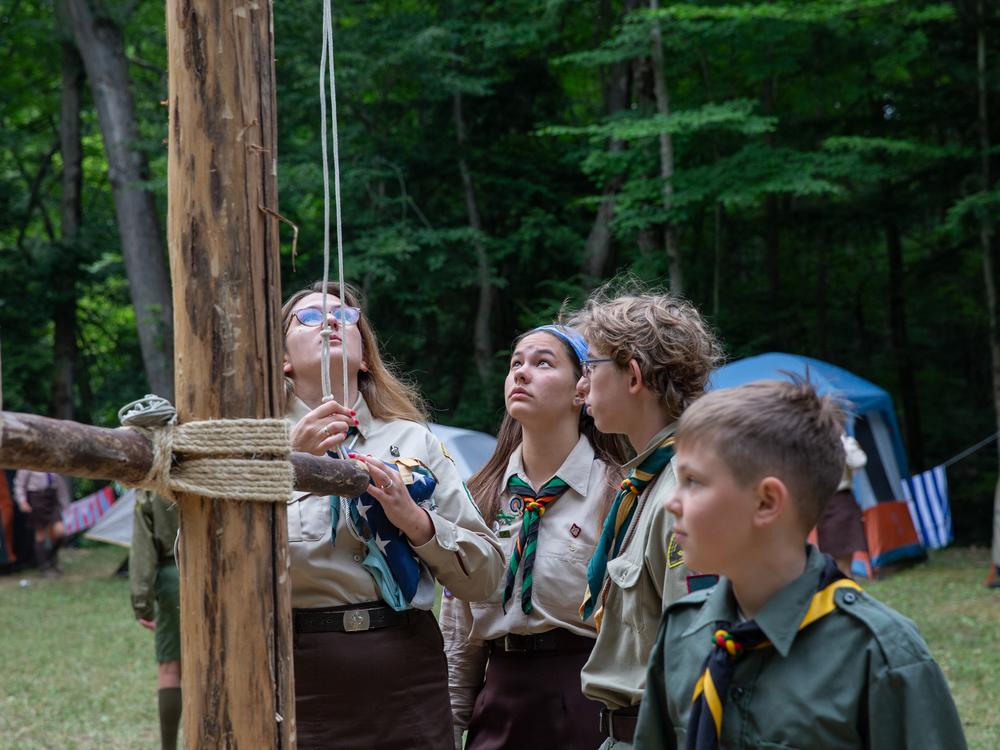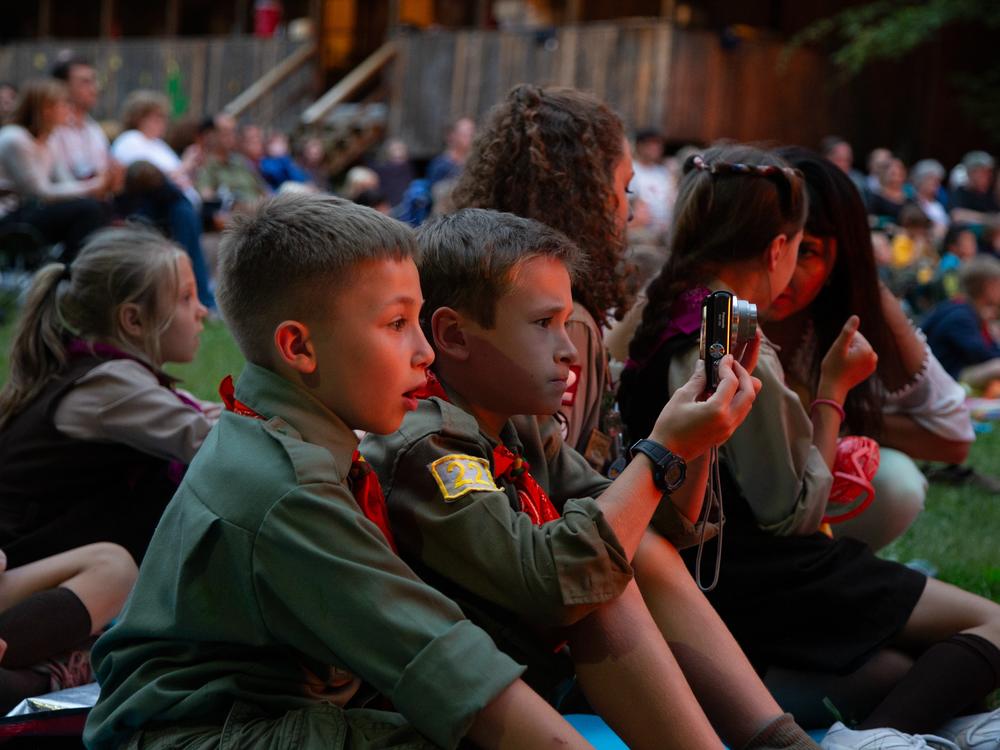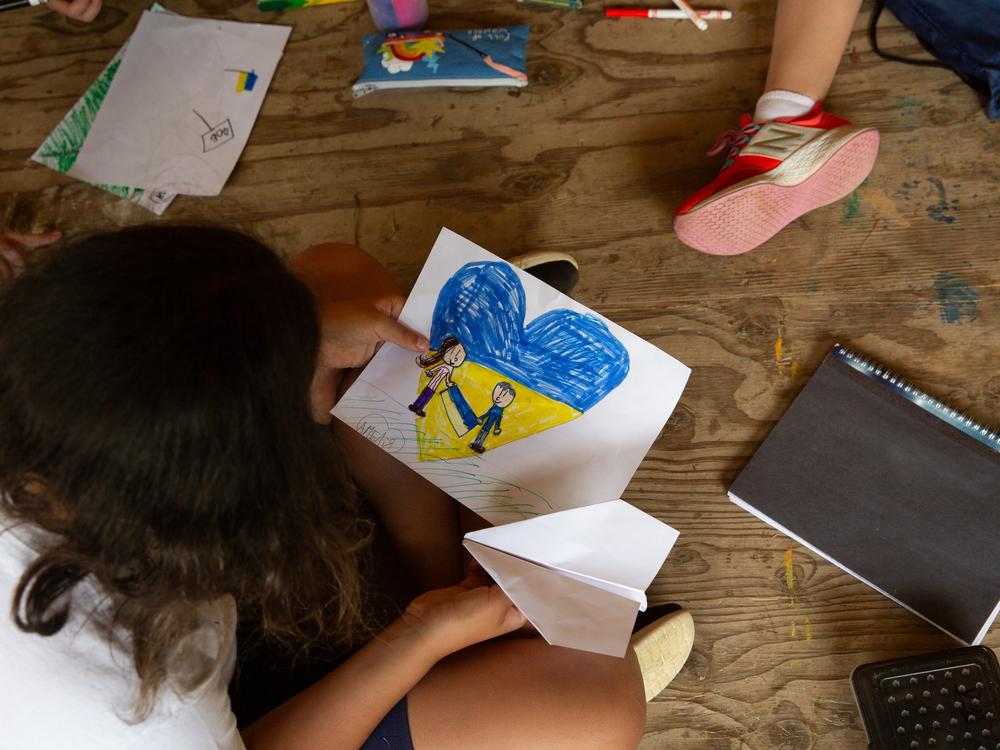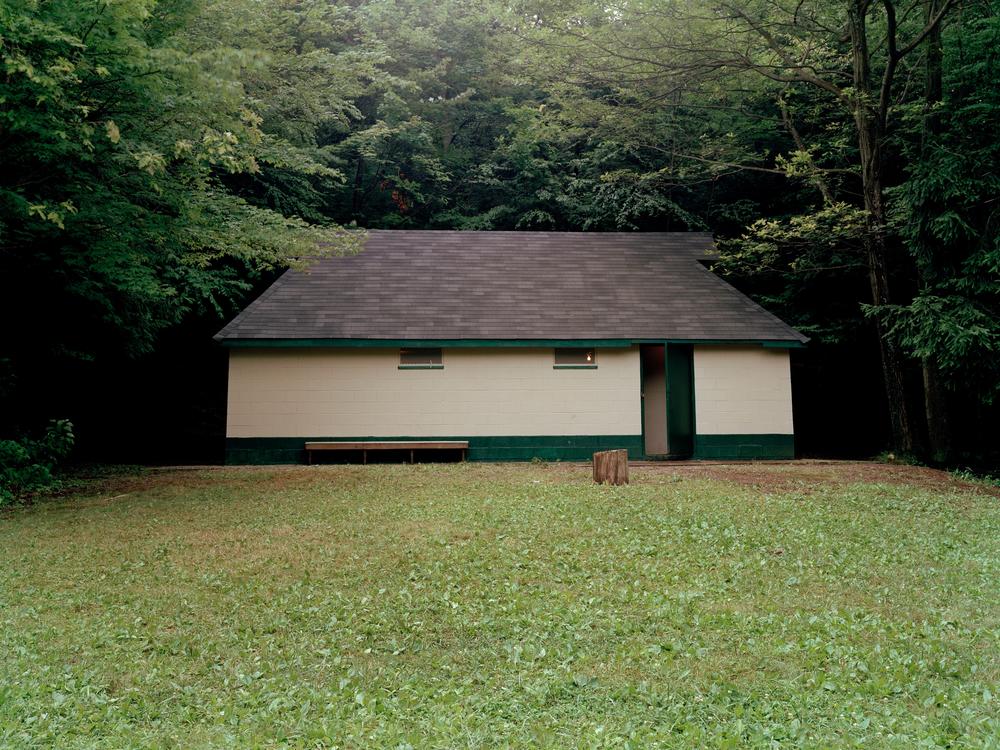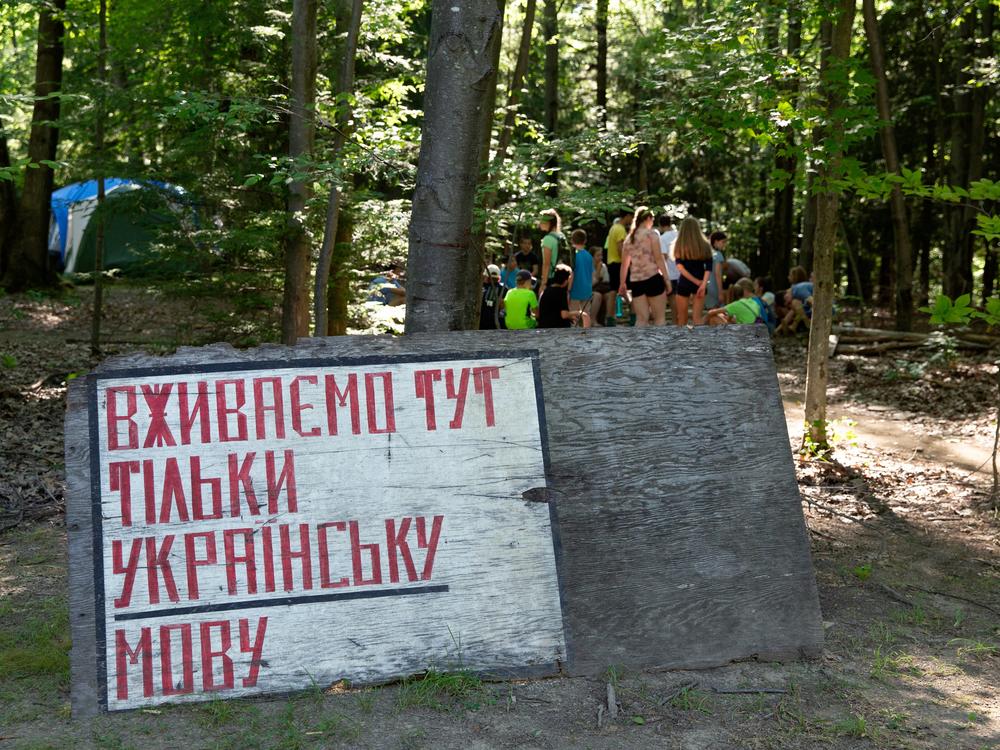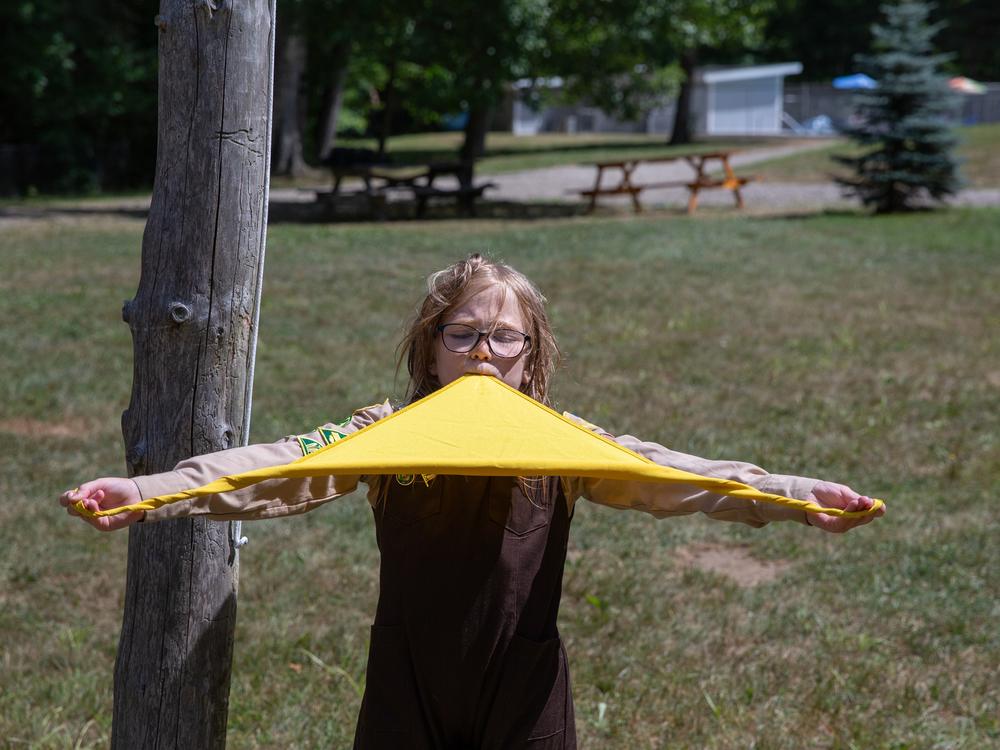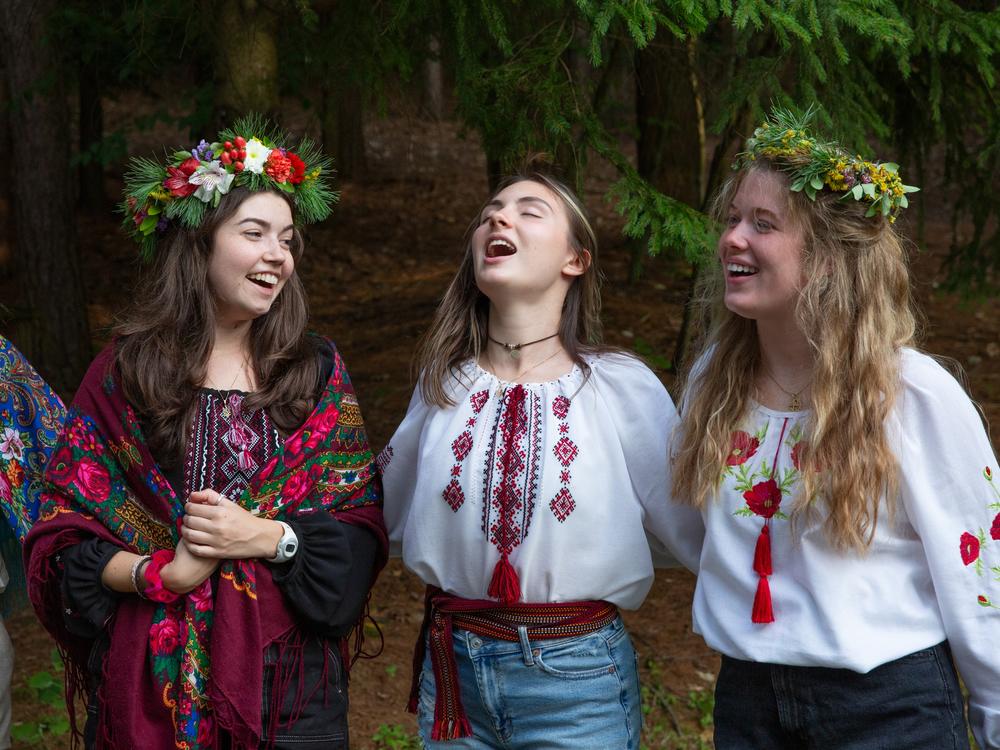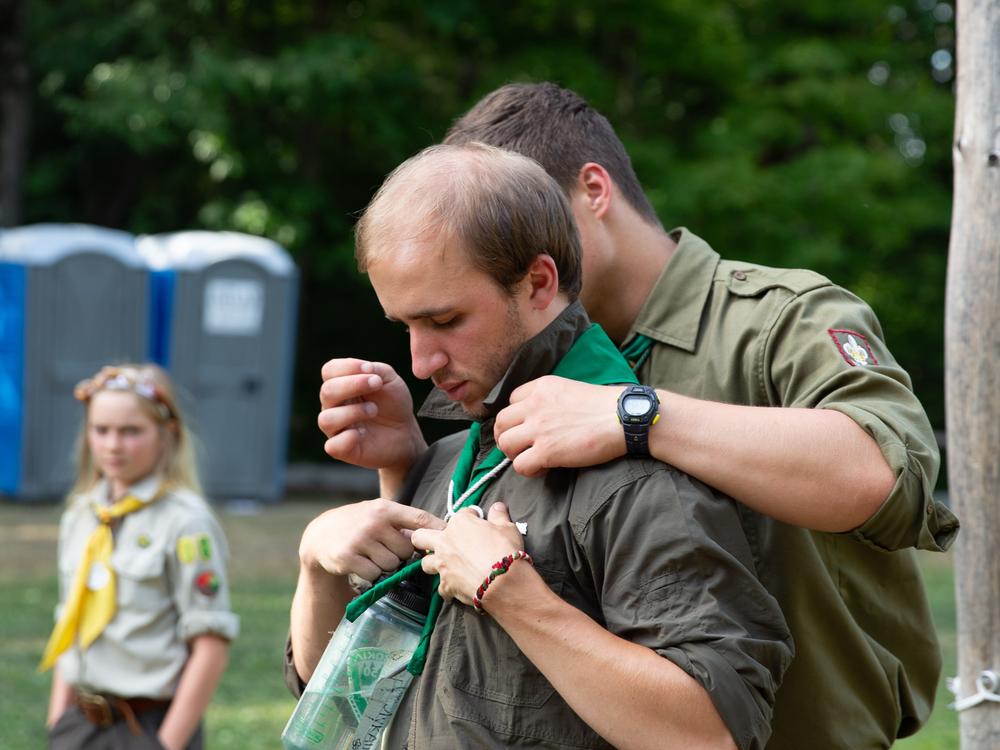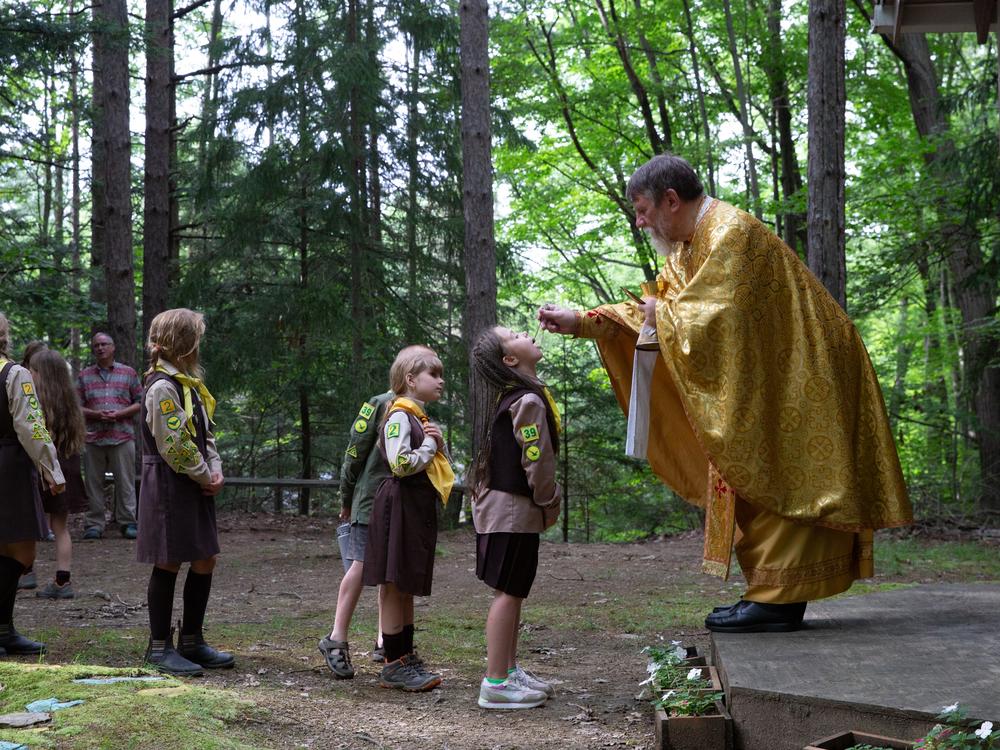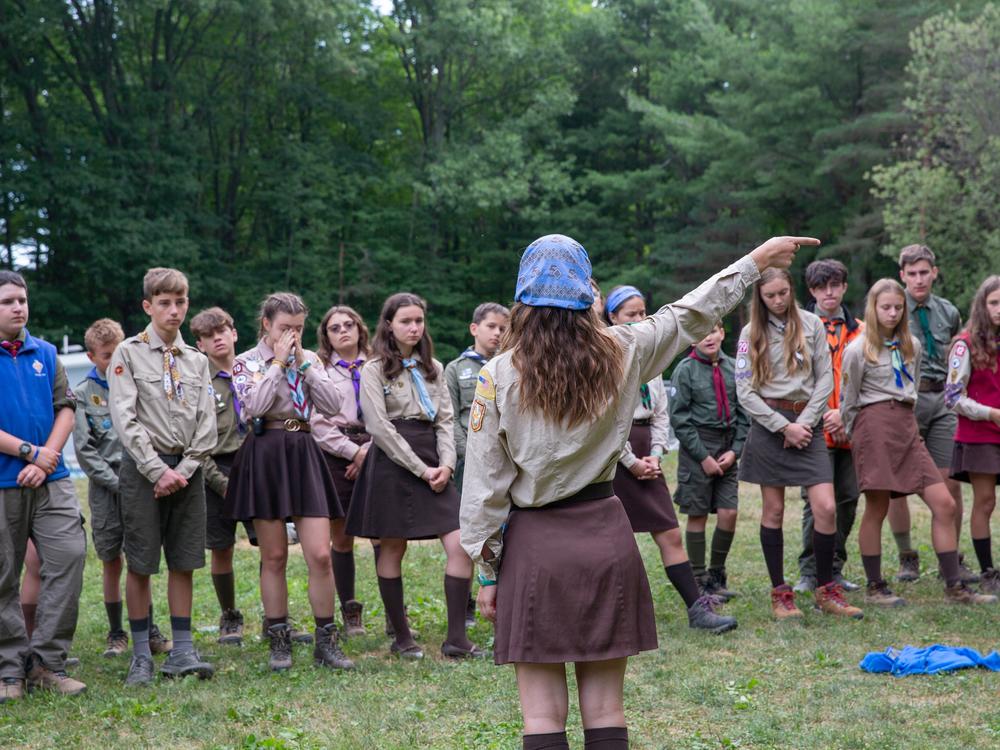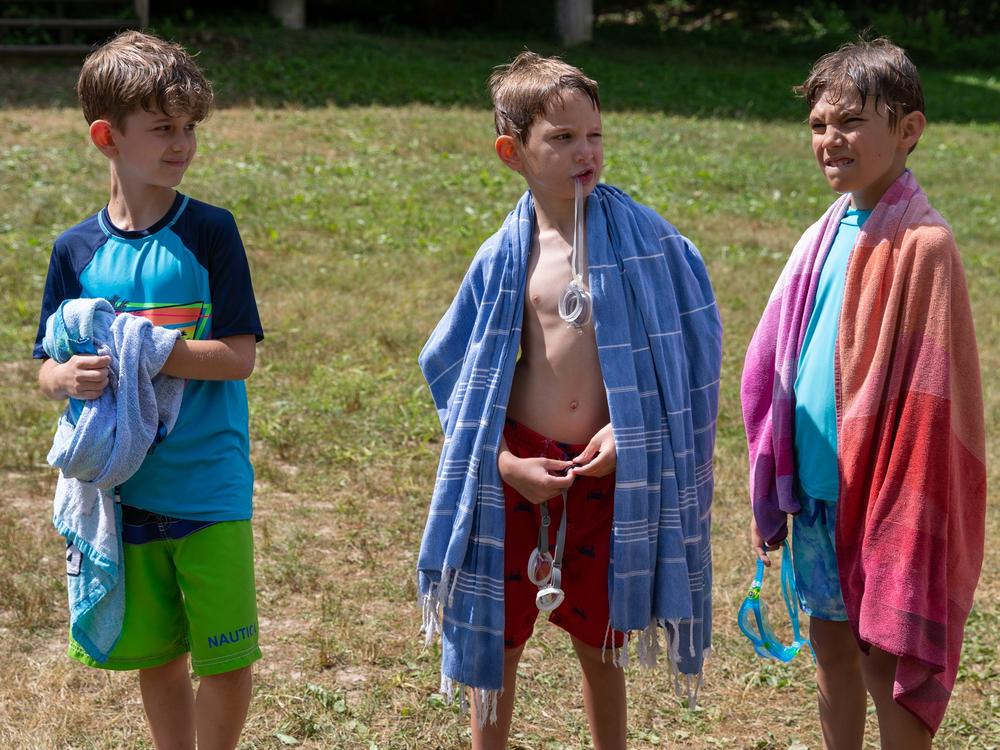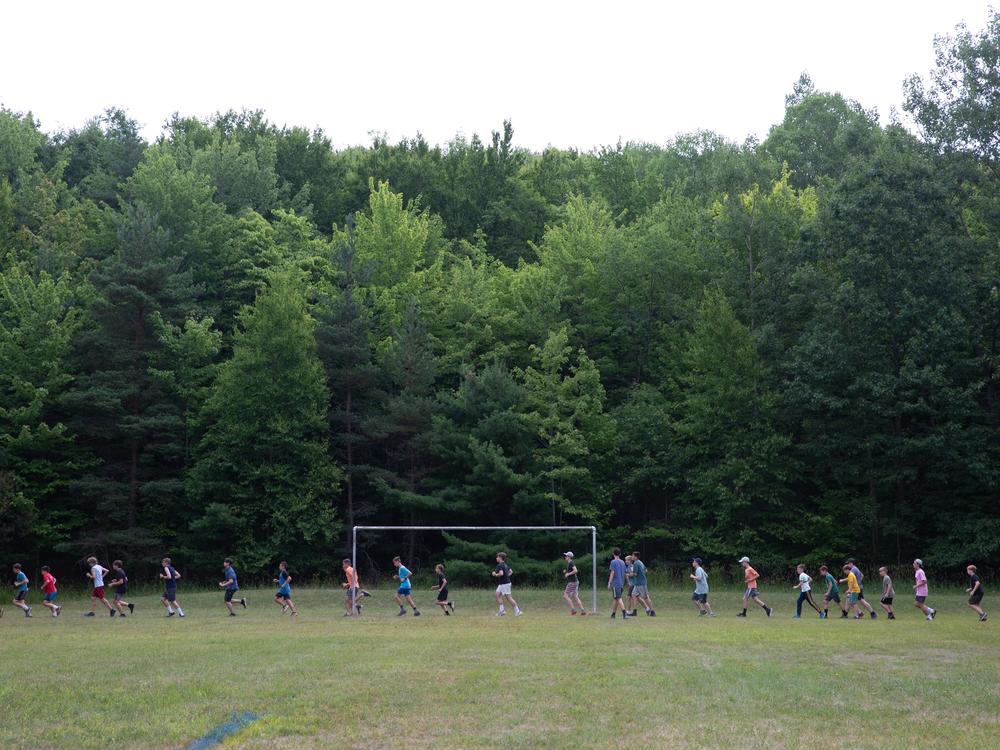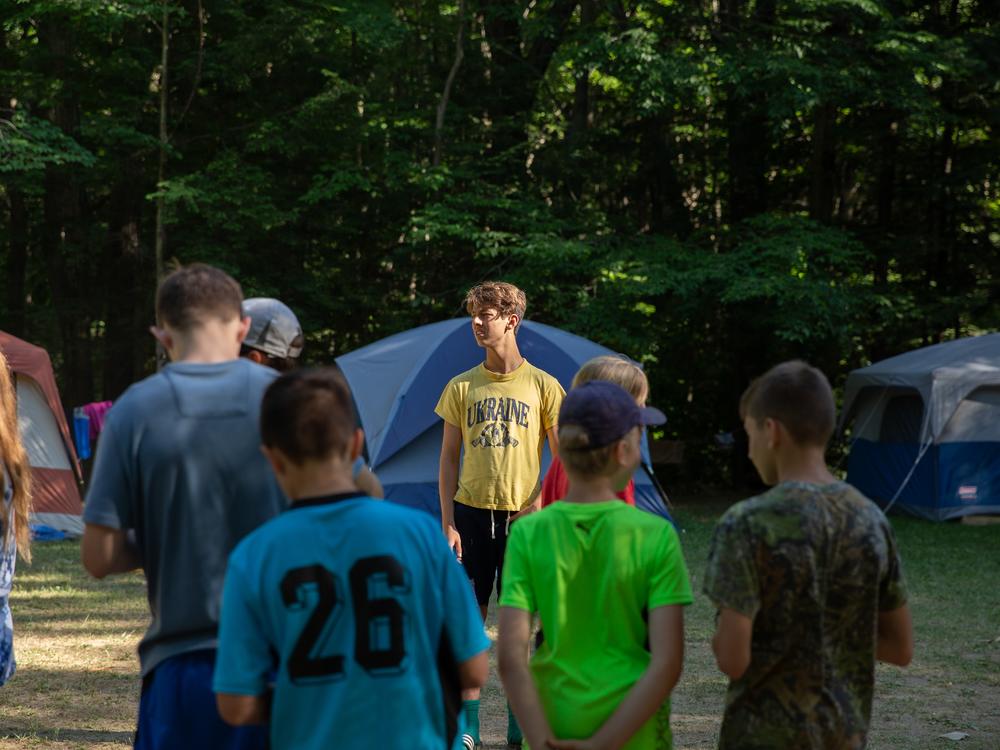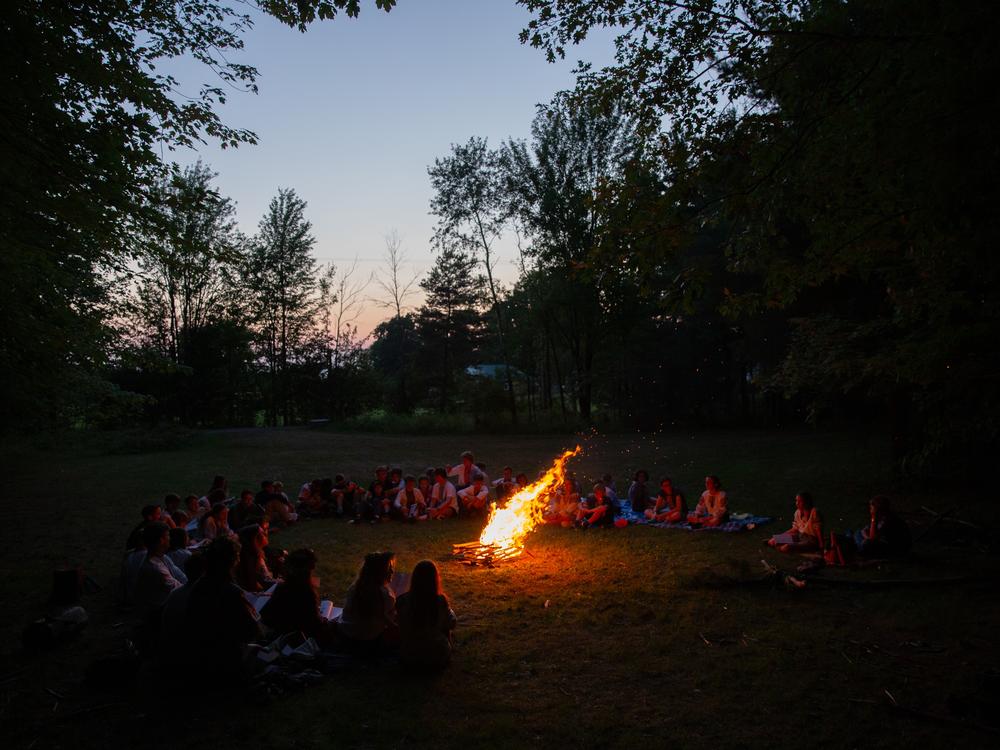Section Branding
Header Content
How Ukrainian scouting culture thrives in the woods of western New York state
Primary Content
There is a parcel of land hidden away in the woods of western New York state that has been home to a Ukrainian summer camp called “Novyi Sokil” since 1950. Every July, campers, counselors and administrators gather on 84 acres of hilly woods, featuring a deep ravine with a meandering creek and fields of grasses and wildflowers, for three weeks of developing lifelong friendships, mosquito bites, campfires and immersion into Ukrainian scouting culture.
The grounds are marked with cyrillic signage pointing them to the outdoor church, kitchen and pool, walking the same rooty paths their grandparents did. Every morning, blue and yellow flags are raised alongside American flags while they sing a repertoire of Ukrainian prayers and scouting songs. The shrill sound of a whistle mingles with crickets in the fields as they practice marching drills that are meant to teach discipline and order. Each camper earns badges, wears a specific uniform, is expected to speak only Ukrainian and follow a scouting code.
I was a camper there in the 1980s and ‘90s and experienced all of this exactly. As I’ve visited with my camera as an adult, I have learned about the unwavering commitment to maintaining this beautiful space and the arduous work it entails. I envision the land as a theater set where core summer memories are made while tightly holding onto a culture in danger of disappearing. In these American woods, they are free to be Ukrainian, and more specifically, a Ukrainian Plast Scout.
A tenacious history
Plast, the Ukrainian Scouting organization, started in 1912 in Lviv, Ukraine (then part of Galicia) by three teachers: Oleksandr Tysovsky, Petro Franko and Ivan Chmola. Separately, they were inspired by the teachings of Robert Baden-Powell, the founder of the Scout movement. There is a focus on nature, personal development and not only celebrating Ukrainian culture but raising exceptional citizens of Ukrainian society, which remains the core philosophy to this day. The three principal obligations of a Plast Scout are: “To be faithful to God and Ukraine, To help others, and To live by the Plast Code and obey Plast leadership.”
By 1930, Plast in Ukraine was dissolved by the Polish authorities and existed underground and under different names through WW1, Soviet rule, German occupation and the USSR until its dissolution in 1991. Scout leaders continued to organize wherever they ended up: displaced persons camps in Germany and Austria after WW2, and finally in countries where diasporas settled like the United States, Canada, Australia, Argentina, Britain, Germany, Poland and Slovakia.
Celebrating 75 years
Two of these leaders, Siryy Lev and Marian Borachok, displaced from Ukraine to Buffalo, N.Y., found an abandoned farm for camping in the nearby rural village of North Collins. In 1950, it had a population of under 2,000 people, and today, close to 3,500. With the help of neighboring communities in Rochester, N.Y., and Cleveland, Ohio, these Plast Scouts, or “Plastuny,” purchased the land in 1951 for $2,500, officially marking Novyi Sokil as the first Plast camp in the United States.
My mom came here as a teenager in the 1950s, then a place without electricity, running water or buildings. She remembers sleeping in a tent and having to bathe in the creek; a far cry from the salt water inground pool, filtered water pumps and electricity in all the buildings of today.
It’s estimated that over 8,000 campers have attended Novyi Sokil in its history. They have come from as far as Sweden, South Africa and Ukraine, though most of the campers visit from the U.S. and Canada. Refugees from Ukraine in recent years will be in attendance; for many of them, it’s their first time camping. Counselors have told me that the kids blend seamlessly, and they often debate about the Ukrainian language. There is a marked difference in vocabulary from native, current-day Ukrainians and diasporic Ukrainians who learned a Galician dialect from their grandparents.
“It’s important for me to be here in this welcoming community because I still get to continue learning about my Ukrainian heritage, history and language,” Natalya Chan, age 17 from Ontario, Canada, shared. “It [the war in Ukraine] makes me emotional knowing that I get to be here surrounded by all my Ukrainian friends while knowing that people in Ukraine aren’t with their loved ones.”
Daily life at Novyi Sokil
The camp is divided into two age groups. The younger kids, or novatstvo, which range in age from 6-11, sleep in barracks and work on badges through crafts, songs and play. The counselors develop a strong bond with the campers, who often experience bouts of homesickness. Every summer, they explore a camp theme, such as a “Train Ride Through Ukraine.” Symbols like the blue and yellow flag, embroidery motifs, the Ukrainian trident and floral head wreaths adorn the barracks. They all wear yellow kerchiefs with their uniforms.
The scouts graduate to become younatsvo, which range in age from 11 through the end of high school and sleep in tents and do pioneering activities, like building gates from fallen logs and learning wilderness survival skills. The intensity of their activities increases with age, and they also engage more deeply with Ukrainian history and culture. They get to have supervised parties in the evenings, too.
The campers’ kerchief colors are dependent on the home troop that they belong to. After they complete their sophomore year of high school, they can then attend a special camp to become counselors for the younger campers. After the age of 18, they all become part of the older “Plastun” rank, and can continue to be Plast scouts for the rest of their lives.
“My grandfather was one of the founders of the camp in 1950. My father attended the first camp there in 1951. They have both spent a lot of time taking care of the property and ensuring its livelihood since then. My siblings and I also attended camps while we were growing up. Now, I want to continue the family tradition with my own kids,” shares one of the administrators, Chrystia Paszkowsky, 49, from Buffalo, New York.
All ages follow a similar routine that includes beginning and end-of-day ceremonies, swimming, badge-earning, singing, meals, sports, campfires and weekly Ukrainian Catholic Mass. Every time they need to gather, they are called with a shrill whistle and the yelling of the word, “Zbirka!”, which translates to “collection” and is meant for the campers to gather in a straight line at attention to commence the next activity.
The administrators of the camp do the important, behind-the-scenes work of permits, safety, scheduling field trips, health inspection and finances. Camp is built in such a way that the team of counselors ages 16 and older invent the programming and activities. Adults are largely absent from daily life, and this ecosystem self-monitors within Plast’s curriculum. Each leadership team is made up of a head counselor, secretary and a “Bonchuzhnyi,” who is in command of scheduling, time keeping and leading the campers in mandatory marching skills.
An (un)certain future
As a kid, the impact of the work required to maintain this camp goes unnoticed. The campers show up to be “Plastuny,” and in turn activate the space with song, laughter and being with their Ukrainian friends for three weeks out of the year. I marvel at the drive of the administration to do the incredibly hard work of building not only a safe physical space, but a cultural enclave that kids want to return to year after year. It’s an annual struggle: finding the staff and money because the camp must go on.
All of these innovations and upkeep come at a great dedication and cost. Over the span of three quarters of a century, funds were raised through personal donations and crowdfunding efforts to expand the acreage and build the barracks, outdoor church, pool, latrine and more. Every year, a handful of local helpers show up with machinery to clear away debris and make improvements. Novyi Sokil is now one of three functioning Ukrainian Plast camps in the United States.
Plast leaders have persevered through attacks on Ukrainian culture for over a century, because the desire to exist peacefully as a community, celebrate traditions and speak their own language is a human right. Since the goal of the organization is to raise patriotic young Ukrainians, this was deemed a threat by the authorities that governed Ukraine for most of the 20th century: the Poles, Germans and Soviets. In the 1930s, Plast leaders would meet out of uniform and camp deep in the Carpathian mountains in western Ukraine. They started a magazine for youth called Vohni, or "Fires," that printed up to 50 copies despite police raids and confiscations. Leaders who managed to survive the German and Soviet occupations of the 1940s continued to teach the Plast values under organizations of different names, and displaced Ukrainians continue to work against the sway of assimilation.
This woodsy camp is a symbol of the determination to fight for Ukraine’s freedom, especially in light of its uncertain future, as Russia’s full-scale invasion continues. As Novyi Sokil’s 75th anniversary approaches, with its vibrant guardianship, it’s clear that it won’t be disappearing anytime soon.
“I know my family is really big on culture and keeping it alive,” says Larysa, a 17 year old from Chicago. “In the war in Ukraine, their focus is to protect Ukraine. Going to camp is important because we are being taught to keep our roots alive from a young age, so we know what to pass on to future generations.”
